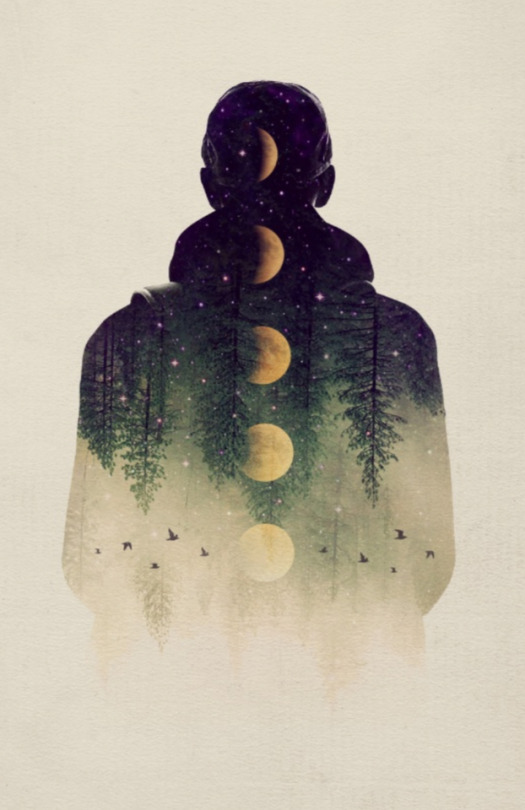I-need-some-space-man-blog - Lexi :)

More Posts from I-need-some-space-man-blog and Others

Flowing Inspiration: by Enkel Dika.
You’ll meet her, she’s very pretty, even though sometimes she’s sad for many days at a time. You’ll see, when she smiles, you’ll love her.
Pan’s Labyrinth, Dir. Guillermo del Toro (via wordsnquotes)
Solar System: Things to Know This Week
Jupiter, we’ve got quite the photoshoot planned for you. Today, our Juno spacecraft is flying directly over the Great Red Spot, kicking off the first-ever close-up study of this iconic storm and passing by at an altitude of only 5,600 miles (9,000 kilometers). In honor of this historic event, below are 10 things to know about the planet’s most famous feature.

1. A Storm That Puts Others to Shame
The Great Red Spot is a gigantic, high-pressure, ancient storm at Jupiter’s southern hemisphere that’s one of the longest lasting in the solar system. It’s so large, about 1.3 Earths could fit inside of it. And you can bet you’ll get swept away—the storm’s tumultuous winds peak at about 400 mph.
2. How Old Is It?
The Great Red Spot has been swirling wildly over Jupiter’s skies for the past 150 years—maybe even much longer. While people saw a big spot on Jupiter when they started stargazing through telescopes in the 1600s, it’s still unclear whether they were looking at a different storm. Today, scientists know the Great Red Spot has been there for a while, but they still struggle to learn what causes its swirl of reddish hues.

3. Time for That Close-Up
Juno will fly over the Great Red Spot about 12 minutes after the spacecraft makes the closest approach to Jupiter of its current orbit at 6:55 p.m. on July 10, PDT (9:55 p.m. on July 10, EDT; 1:55 a.m. on July 11, Universal Time). Juno entered orbit around Jupiter on July 4, 2016.
4. Oh, So Mysterious
Understanding the Great Red Spot is not easy, and it’s mostly Jupiter’s fault. The planet a thousand times as big as Earth and consists mostly of gas. A liquid ocean of hydrogen surrounds its core, and the atmosphere consists mostly of hydrogen and helium. That translates into no solid ground (like we have on Earth) to weaken storms. Also, Jupiter’s clouds make it hard to gather clear observations of its lower atmosphere.

This false-color image of Jupiter was taken on May 18, 2017, with a mid-infrared filter centered at a wavelength of 8.8 microns, at the Subaru Telescope in Hawaii, in collaboration with observations of Jupiter by NASA’s Juno mission. Credit: NAOJ/NASA/JPL-Caltech
5. Help From Hawaii
To assist Juno’s investigation of the giant planet’s atmosphere, Earth-based telescopes lent their helpful eyes. On May 18, 2017, the Gemini North telescope and the Subaru Telescope—both located on Hawaii’s Mauna Kea peak—simultaneously examined Jupiter in very high resolutions at different wavelengths. These latest observations helped provide information about the Great Red Spot’s atmospheric dynamics at different depths and at other regions of Jupiter.
6. Curious Observations
Observations from Subaru showed the Great Red Spot “had a cold and cloudy interior increasing toward its center, with a periphery that was warmer and clearer,” said Juno science team member Glenn Orton of our Jet Propulsion Laboratory, Pasadena, California. “A region to its northwest was unusually turbulent and chaotic, with bands that were cold and cloudy, alternating with bands that were warm and clear.”

This composite, false-color infrared image of Jupiter reveals haze particles over a range of altitudes, as seen in reflected sunlight. It was taken using the Gemini North telescope in Hawaii on May 18, 2017, in collaboration with observations of Jupiter by our Juno mission. Credits: Gemini Observatory/AURA/NSF/NASA/JPL-Caltech
7. Hot in Here
Scientists were stumped by a particular question: Why were the temperatures in Jupiter’s upper atmosphere comparable to those found at Earth, even though Jupiter is more than five times the distance from the sun? If the sun isn’t the heat source, then what is? Turns out, the storm in the Great Red Spot produces two kinds of turbulent energy waves that collide and heat the upper atmosphere. Gravity waves are much like how a guitar string moves when plucked, while acoustic waves are compressions of the air (sound waves). Heating in the upper atmosphere 500 miles (800 kilometers) above the Great Red Spot is thought to be caused by a combination of these two wave types “crashing,” like ocean waves on a beach.

8. Color Theory
Scientists don’t know exactly how the Great Red Spot’s rich colors formed. Studies predict Jupiter’s upper atmosphere has clouds consisting of ammonia, ammonium hydrosulfide, and water, but it’s still unclear how or even whether these chemicals react. “We’re talking about something that only makes up a really tiny portion of the atmosphere,” said Amy Simon, an expert in planetary atmospheres at NASA’s Goddard Space Flight Center in Greenbelt, Maryland. “That’s what makes it so hard to figure out exactly what makes the colors that we see.” Over at NASA’s Jet Propulsion Laboratory in Pasadena, California, researchers concluded that the ruddy color is likely a product of simple chemicals being broken apart by sunlight in the planet’s upper atmosphere. “Our models suggest most of the Great Red Spot is actually pretty bland in color, beneath the upper cloud layer of reddish material,” said Kevin Baines, a Cassini scientist at JPL.
9. Been There, Haven’t Seen That
In January and February 1979, NASA’s Voyager 1 spacecraft zoomed toward Jupiter, capturing images of the Great Red Spot during its approach. Still, we’ve never been as close as we’re about to get during Juno’s flyover on July 10.

10. Simply Beautiful
This image of a crescent Jupiter and the iconic Great Red Spot was created by a citizen scientist, Roman Tkachenko, using data from Juno’s JunoCam instrument. JunoCam’s raw images are available here for the public to peruse and enhance.Want to learn more? Read our full list of the 10 things to know this week about the solar system HERE.
Make sure to follow us on Tumblr for your regular dose of space: http://nasa.tumblr.com
When the right one comes along, you figure it out. You move mountains, you change your life and you do whatever it takes to keep them with you.
Jay Crownover, Jet (via wordsnquotes)

You never, ever, ever, get over some things. And time doesn’t heal them. You just learn to manage them. But they’re always there.
wordsbyt (via wnq-writers)

I want to believe



-
 lupine-lavender reblogged this · 2 years ago
lupine-lavender reblogged this · 2 years ago -
 tryingdmt reblogged this · 3 years ago
tryingdmt reblogged this · 3 years ago -
 tryingdmt liked this · 3 years ago
tryingdmt liked this · 3 years ago -
 293874774828 reblogged this · 3 years ago
293874774828 reblogged this · 3 years ago -
 commandmentannexed reblogged this · 3 years ago
commandmentannexed reblogged this · 3 years ago -
 acept-arte liked this · 4 years ago
acept-arte liked this · 4 years ago -
 m-miikaelson liked this · 4 years ago
m-miikaelson liked this · 4 years ago -
 reason-for-life reblogged this · 4 years ago
reason-for-life reblogged this · 4 years ago -
 codedreams reblogged this · 4 years ago
codedreams reblogged this · 4 years ago -
 codedreams liked this · 4 years ago
codedreams liked this · 4 years ago -
 dazzling-dark reblogged this · 4 years ago
dazzling-dark reblogged this · 4 years ago -
 dazzling-dark liked this · 4 years ago
dazzling-dark liked this · 4 years ago -
 born2love5 liked this · 4 years ago
born2love5 liked this · 4 years ago -
 serendipiaxxiv liked this · 4 years ago
serendipiaxxiv liked this · 4 years ago -
 metallic-dxceiver liked this · 4 years ago
metallic-dxceiver liked this · 4 years ago -
 alguienanormal liked this · 4 years ago
alguienanormal liked this · 4 years ago -
 rayychel5 liked this · 4 years ago
rayychel5 liked this · 4 years ago